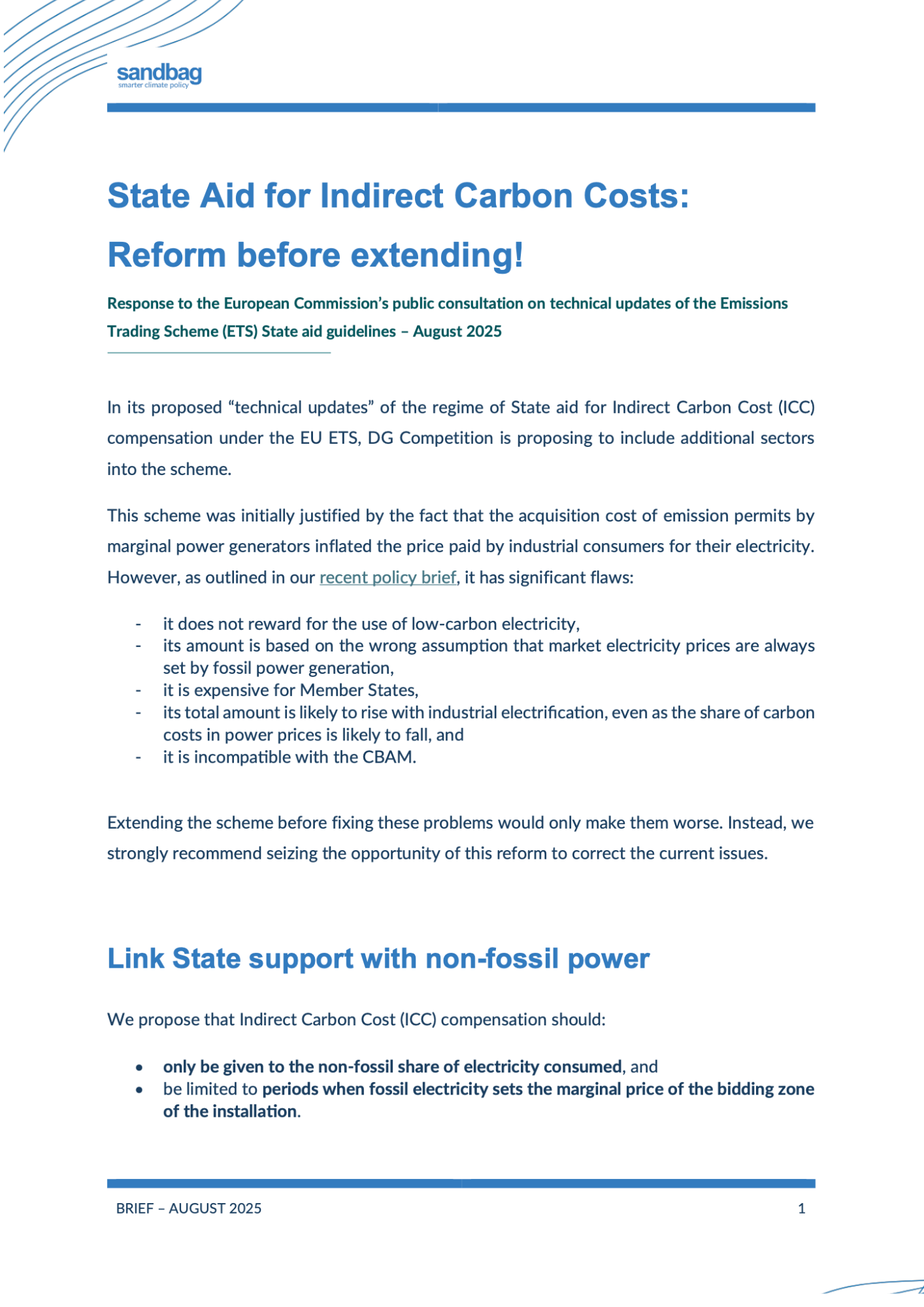This document is Sandbag’s response to the European Commission’s public consultation on technical updates of the regime of State aid for Indirect Carbon Cost (ICC) compensation under the EU ETS. DG Competition is proposing to include additional sectors into the scheme.
This scheme was initially justified by the fact that the acquisition cost of emission permits by marginal power generators inflated the price paid by industrial consumers for their electricity.

However, as outlined in our recent policy brief, the Indirect Carbon Cost scheme has significant flaws:
- it does not reward for the use of low-carbon electricity,
- its amount is based on the wrong assumption that market electricity prices are always set by fossil power generation,
- it is expensive for Member States,
- its total amount is likely to rise with industrial electrification, even as the share of carbon costs in power prices is likely to fall, and
- it is incompatible with the CBAM.
Extending the scheme before fixing these problems would only make them worse. Instead, we strongly recommend seizing the opportunity of this reform to correct the current issues.
Link State support with non-fossil power
We propose that Indirect Carbon Cost (ICC) compensation should:
- only be given to the non-fossil share of electricity consumed, and
- be limited to periods when fossil electricity sets the marginal price of the bidding zone of the installation.
Currently, all electricity consumed by the industry sectors covered is eligible for compensation, including fossil electricity, which provides no incentive for consumers to source low-carbon electricity. Industrial installations using 24-hour grid electricity are rewarded as much as those bearing the cost of adjusting operations to intermittent renewable sources. Applying ICC compensation to the non-fossil share of electricity would better incentivise virtuous behaviours by electro-intensive industries.
Limiting the amount paid to times when fossil electricity sets the marginal price would avoid windfall profits made by firms using electricity bought from the market at times of low prices, when fossil generation is not reflected in market prices. It would also reduce costs for Member States paying out this support, as the share of low-carbon electricity soars in electricity grids, together with the frequency of such events.
Ensure compatibility with the CBAM
As well as the benefits listed above, our proposed reform for ICC compensation would be compatible with an extension of the CBAM to indirect emissions. Integrating indirect emissions into the CBAM cannot be done with the compensation regime in place in its current form, because it would unfairly compensate EU producers while importers are taxed.
In contrast, our proposed reform to ICC compensation would be compatible with the CBAM because the scope of ICC (fossil-free electricity) and the CBAM (fossil-based electricity) would be different.
Including indirect emissions in the CBAM would have many advantages: it would improve environmental integrity by putting a price on imported indirect emissions, avoid competitive disadvantages with EU trade partners, reduce ICC’s fiscal burden as the CBAM raises funds, and future-proof the CBAM as industrial electrification may increase the share of indirect emissions.
For further elaboration of these points, please read our recent brief on this topic: Extending the CBAM to indirect emissions.
In the news
-
Carbon Pulse, 21 August 2025: Think tank urges European Commission to address major flaws in carbon compensation mechanism carbon-pulse.com+3carbon-pulse.com+3carbon-pulse.com+3
-
Contexte, 28 August 2025: EU: The indirect carbon cost compensation mechanism must stop financing fossil electricity consumption, says think tank Sandbag
Related publications
An Export Solution for a Faster CBAM Phase-in
A Carbon Border Adjustment Mechanism (CBAM) has been proposed by the European Commission as an...
Our concerns regarding ETS and CBAM legislative texts
We have strong concerns regarding the legislative texts on the revision of the Emissions Trading...
2nd ETS trilogue: EU institutions agreed on almost nothing, except on perpetuating free allocation for the steel giants
The second ETS trilogue took place last week on October 11th. Tabled proposals on benchmarks regarding the steel…



